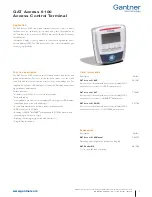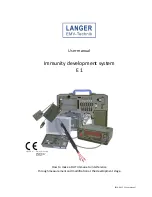
9
Instructional Leaflet
IB48041
Effective December 2009
Instructions for AMPGARD 400A
medium voltage starter
eaton corporatIon
www.eaton.com
Mechanical interlocks should be checked as follows: Isolate and lock
out all incoming power sources. Open the isolation switch. Open the
medium voltage door. Verify that the mechanical interlocks between
the contactor and handle mechanism are connected and function-
ing properly. The switch drive rod connection and the contactor
interlock rod connections should be verified by operating the handle
mechanism, open-to-close-to-open. The door interlock plunger must
be held in by hand during this operation. Verify that the pivot arm
on the handle mechanism drops down and makes contact with the
cam after the handle is fully closed. Failure to contact the cam may
indicate a problem with the adjustment of the aluminum interlock
arm on the contactor. Close the main contactor with test power
and attempt to operate the switch while holding the door interlock
plunger in. The mechanical interlock should prevent the switch from
operating. Avoid putting excessive force on the operating handle dur-
ing this operation or damage to the handle mechanism may occur.
Figure 21. Mechanical Interlock Verification
Maintenance
A maintenance program should be established as soon as the
controller has been installed and put into operation. After the
controller has been inspected a number of times at monthly
intervals and the conditions noted, the frequency of inspection
can be increased or decreased to suit the conditions found.
Before attempting maintenance, consult the order-specific drawings
and instructions supplied with the controller.
Insulation level
The insulation resistance between poles, and from each pole to
ground, should be measured and recorded. It is not practical to
specify an absolute value for this reading because it is dependent on
other connected apparatus and conditions of service. However, any
unusually low reading or abrupt reduction in a reading would indicate
a possible source of trouble, and the cause should be investigated
and corrected.
Fuses
Inspect the current-limiting fuses after each relay initiated trip,
because this is the most severe service to which they will be sub-
jected. Check the fuse resistance, and compare with the value of
a new fuse. A visual sign of an open fuse is provided by a pop-up
indicator on the top of the fuse. If a fuse has blown due to a fault,
it is likely that the other fuses experienced a similar overcurrent
condition. In this case, Eaton recommends that all three fuses be
replaced. Ensure that the replacement fuses are of the same rating
and mounting configuration as those originally supplied.
Clip-in fuses can be removed by simply pulling them from the
fuse clips. Lightly lubricate fuse clips with Dow DC-4 high-temp
dielectric compound before installation of new fuses to reduce
the force required to insert and remove fuses. Bolt-in fuses can be
removed by loosening the four nuts that secure the fuses to their
mounting studs. The phase barriers on the lower fuse mountings
can be removed if desired to ease access to the mounting studs
and nuts. The upper phase barriers are not removable. If the optional
blown fuse trip bar has been supplied, lift the operating arms up
to clear the fuse mounting flanges. The arms will latch in the up
position. Installation is the reverse of removal. Bolt-in fuses must
be torqued to 25 lb-ft (33 N-m). Be sure to lower the blown fuse
trip bar operating arms after all three fuses are reinstalled.
Contactor
Inspect the contactor line and load fingers for signs of arcing or
overheating. Replace as necessary. Inspect the mechanical interlock
components attached to right side of the contactor main operating
shaft and side sheets. Ensure the lever is secure on the shaft and
that the pivoting arm moves freely. Verify that the finger assemblies
on stab-connected contactors are in their neutral (horizontal)
position before reinserting the contactor into the cell. No lubrication
is required.
Refer to IB 48018N for details of additional contactor operation and
maintenance information.
Follow the steps below to remove the contactor from the starter
cell. Installation is the reverse of the removal process. Note that the
mechanical interlock mechanism on the side of the contactor must
be reconnected before the contactor can be closed. The mechanism
is weighted in such a manner that the contactor cannot operate
until the interlock rod clevis is reconnected.
Figures 22
through
26
illustrate the removal sequence.
1.
Unplug control harness
2.
Remove bolt from hold-down bracket
3.
Unsnap pin collar from interlock rod clevis
4.
Remove pin from interlock rod clevis
5.
Remove bolts for contactor line and load connections
(bolt-in unit only)
6.
Withdraw contactor from cell
Figure 22. Unplug Control Harness
Figure 23. Remove Bolt-Down Hardware
Switch
Drive Rod
Contactor
Interlock
Rod
Door
Interlock
Plunger
Pivot Arm
Cam
Contactor
Interlock
Arm
Bolt






























